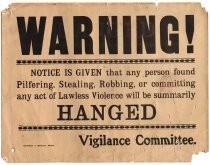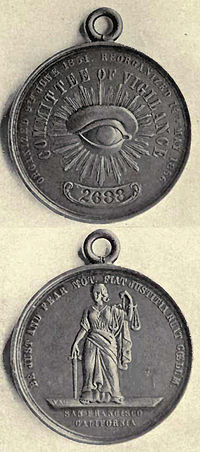The Vigilance Committees of San Francisco
Guardians or Vigilantes?
By Christopher Robison
2023-12-02

San Francisco in the 1850s was a city of stark contrasts. It was a burgeoning hub of opportunity following the Gold Rush of 1849, attracting fortune-seekers, entrepreneurs, and adventurers. However, this rapid growth also attracted criminals who brought lawlessness, corruption, and crime. Amidst this chaotic backdrop, the Vigilance Committees emerged, a phenomenon unique in the annals of American history.
The Birth of the Vigilance Committees
In 1851 on June 13th, the Daily Alta California printed the following in it’s morning edition:
WHEREAS it has become apparent to the citizens of San Francisco, that there is no security for life and property, either under the regulations of society as it at present exists, or under the law as now administered; Therefore the citizens, whose names are hereunto attached, do unit themselves into an association for the maintenance of the peace and good order of society, and the preservation of the lives and property of the citizens of San Francisco, and do bind ourselves, each unto the other, to do and perform every lawful act for the maintenance of law and order, and to sustain the laws when faithfully and properly administered; but we are determined that no thief, burglar, incendiary or assassin, shall escape punishment, either by the quibbles of the law, the insecurity of prisons. the carelessness or corruption of the police, or a laxity of those who pretend to administer justice.

The first Vigilance Committee formed in 1851 in response to alleged arson by the “Sydney Ducks” gang. San Francisco’s rapid population explosion, completely unregulated, had led to a sharp increase in crime, particularly violent assaults and robberies. The existing local legal and law enforcement systems were woefully inadequate, often corrupt, and sometimes complicit in the criminal activities they were supposed to be suppressing.
In response, a group of around 700 concerned citizens banded together to form the Committee of Vigilance. Their stated goal was to bypass the ineffective legal system and bring justice to those they deemed criminals. They operated outside the law, setting up their own court, and dispensing what they viewed as swift and fair justice.
The Committee’s Actions and Impact

The committee engaged in policing, investigating disreputable boarding houses and vessels, deporting immigrants, and parading its militia. Four people were hanged by the committee; one was whipped (a common punishment at that time); fourteen were deported to Australia; fourteen were informally ordered to leave California; fifteen were handed over to public authorities; and forty-one were discharged. The 1851 Committee of Vigilance was dissolved during the September elections, but its executive members continued to meet into 1853.
Their methods were controversial; they often relied on dubious evidence and hearsay. Despite this, many San Franciscans supported their actions, seeing them as a necessary response to an untenable situation. Their impact was felt not just in the reduction of crime but also in the political sphere. The Committee actively sought to remove corrupt officials and influence local politics. They were instrumental in reshaping the city’s governance, pushing for reforms and better law enforcement practices.
The 1856 Committee: A Sequel with Greater Force

The Vigilance Committee re-emerged in 1856 with even greater force, following the assassination of a popular journalist, James King of William, by James P. Casey, a city supervisor. This event triggered widespread outrage and led to the reformation of the Committee, now with thousands of members, including some of the most influential citizens.
The 1856 Committee was more organized and had a broader agenda. It targeted not only common criminals but also corrupt politicians and businessmen. Their actions led to the exile or flight of numerous city officials and the restructuring of the city government.
Criticisms and Controversies

Despite their popularity among certain sectors of San Francisco’s population, the Vigilance Committees were not without their critics. They were seen by some as a usurpation of legal authority, undermining the rule of law. Their methods raised serious questions about due process and the rights of the accused.
The Committee’s unilateral actions also set a dangerous precedent. Their brand of vigilante justice, while perhaps effective in the short term, was at odds with the principles of a lawful, democratic society.
Legacy
The legacy of the Vigilance Committees in San Francisco is complex. On one hand, they played a crucial role in restoring order and pushing for necessary reforms at a time when the city was struggling to govern itself effectively. On the other hand, their methods and disregard for legal procedures left a troubling mark on the city’s history.
Today, the story of the Vigilance Committees serves as a powerful reminder of the challenges that can arise in rapidly growing communities, the dangers of extrajudicial actions, and the enduring struggle to balance security and justice.
In the annals of San Francisco’s colorful history, the Vigilance Committees stand out as a unique and controversial attempt to take control of a city spiraling into chaos. Their story is a testament to the complex nature of justice and the perils of taking the law into one’s own hands.
Leave a Reply
Comment? Suggestion? Just plain mad? Why not Leave a comment and let everyone know what you're thinking. Your email address will never be shared or published. Required fields are marked *